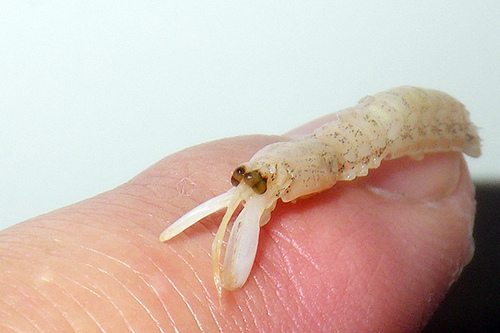
 |
Crustaceans: Mantis Shrimp Rissoides desmaresti
We found an extensive bed of Rissoides desmaresti in June 1999 off Pwllheli/Abersoch during some of our SAC monitoring surveys - it was one of the first diver-observed beds in the UK. The bed was estimated to cover 62 acres at the north end of Cardigan Bay. There are dense concentrations of them off the east side of the East St Tudwall Island just off Abersoch. We also found them off Pwllheli.
Not in the Books
In view of the large numbers that we discovered, it was surprising to note they are not listed in any of the identification guides as a British species.
British Distribution
From
evidence of plankton trawls of the larvae, Rissoides desmaresti
occurs sporadically around the British coast. However, before this bed
was discovered there was not a single confirmed report of the adults. Moderate
numbers of larvae have been found in the planktonic stage, enough to constitute
a British species but not enough for the identification guides. There is
possibly a population of them somewhere off the Isle of Wight and perhaps
around the Plymouth area too (Keith Hiscock mentioned fishermen bringing
them ashore in cod stomachs), although I know of no other diver observations
from anywhere in the country.
Bionomics
The Mantis Shrimps were about 10 cm long. And the numbers were surprising, roughly 1 per square metre over an area of about 0.25 square km (25 hectares, 62 acres), thinning out to around 1 burrow per 100 square metres. i.e. 250,000 plus.
Burrows
In the densest part of the vast bed, the burrows were easily recognisable and distinguishable from those of the Burrowing Prawn Upogebia.
The U-shaped burrows had an entrance about 3 cm across. The exit to the burrow was much smaller and inconspicuous. It was only noticeable when we tried to catch the shrimps, as they use this as an escape route. The bottom of the 'U' flattened off about 15 cm below the surface. The burrows were at a depth of about 8-15 metres below Chart Datum, in sediment comprising of muddy shelly gravel and sand with a sparse scattering of maerl and whole shells.
By approaching the burrows very carefully you occasionally get a glimpse of the Mantis Shrimp sitting a few centimetres down its burrow. Catching them can be a painful experience - not only is the front end particularly well armed (they have a single serrated digit similar to a preying mantis) but the telson is also heavily spined and they use this to stab you repeatedly in the fingers!
Although the report of the Mantis Shrimps actually dated from June 1999, this report was so unusual that I did not include it immediately in this newsletter or the Torpedo Electronic Bulletins. AH.
The identification by Rohan Holt was confirmed by Roger Bamber.
11
February 2016
A
12 cm long Mantis Shrimp, Rissoides
desmaresti, was washed ashore on the
Kent coast. This is the first known record from Kent. The discovery was
made at Greatstone
on the English Channel coast.
|
6 February 2014 Scores of Mantis Shrimps, Rissoides desmaresti, were washed ashore at Felpham, near Bognor Regis, West Sussex. They were discovered by Mike Burgess on the strandline. The records from this area were only in ones or twos before. Report
and Photograph by Mike Burgess
|
 |
 |
c 5 December 2009
A Mantis Shrimp, Rissoides desmaresti, was found in the stomach of a Pouting caught two miles east of the Isle of Wight. The Mantis Shrimp was a little over four inches (just over 10 cm) in length. Report and Photographs by Martin
Lodge
|
December
2009
 |
 |
A Mantis
Shrimp, Rissoides desmaresti,
and a Small-headed Clingfish, Apletodon
dentatus,
were also discovered
in the stomach of a Whiting
caught
off Brighton, Sussex.
Full
Report & Photographs

9 February 2002
After a week of gales, the Mantis Shrimp illustrated
was discovered on the tideline at Calshot Spit, Hampshire. It is probably
Rissoides
desmaresti.
| Phylum: | Arthropoda |
| Subphylum: | Crustacea |
| Class: | Malacostraca |
| Order: | Stomatopoda |
| Superfamily: | Squilloidae |
| Family: | Squillidae |
| Genus: | Rissoides |
| Species: | desmaresti (Risso, 1816) |
|
|
|
|
|
News 2018 |
Membership Form |
|